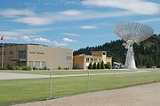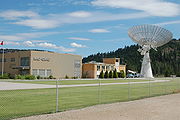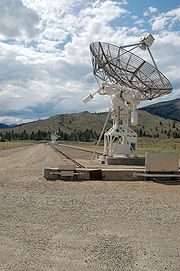
Dominion Radio Astrophysical Observatory
Encyclopedia
The Dominion Radio Astrophysical Observatory is a research
facility founded in 1960 and located south-west of Okanagan Falls, British Columbia
, Canada
. The site houses three instruments – an interferometric radio telescope
, a 26-m single-dish antenna
, and a solar
flux
monitor – and supports engineering
laboratories
. The DRAO is operated by the Herzberg Institute of Astrophysics
of the National Research Council of the Canadian government.

 The interferometric array consists of seven nine-meter, metal-mesh dish antennas along a 600-m east-west line. The antennas are equipped with single-circular polarisation receivers at 408 MHz and dual circular receivers at 1420 MHz, from which all four Stokes parameters
The interferometric array consists of seven nine-meter, metal-mesh dish antennas along a 600-m east-west line. The antennas are equipped with single-circular polarisation receivers at 408 MHz and dual circular receivers at 1420 MHz, from which all four Stokes parameters
may be formed. A spectrometer
may also be employed at 1420 MHz for study of the 21-cm hydrogen line
.
 The single metal-mesh antenna can be equipped to observe at 408 MHz and at 1.5, 2.7, 4.9, 6.6, and 8.4 GHz, including the hydrogen line near 1.4 GHz, the OH lines around 1.6 GHz, and the methanol
The single metal-mesh antenna can be equipped to observe at 408 MHz and at 1.5, 2.7, 4.9, 6.6, and 8.4 GHz, including the hydrogen line near 1.4 GHz, the OH lines around 1.6 GHz, and the methanol
line near 6.6 GHz.
 The monitor consists of two solid-surface dish antennas simultaneously observing at 10.7-cm wavelength.
The monitor consists of two solid-surface dish antennas simultaneously observing at 10.7-cm wavelength.
and the James Clerk Maxwell Telescope
.
The observatory was named an IEEE Milestone for first radio astronomical
observations using VLBI
.
Research
Research can be defined as the scientific search for knowledge, or as any systematic investigation, to establish novel facts, solve new or existing problems, prove new ideas, or develop new theories, usually using a scientific method...
facility founded in 1960 and located south-west of Okanagan Falls, British Columbia
Okanagan Falls, British Columbia
Okanagan Falls is a community located on the south end of Skaha Lake in British Columbia. Originally named Dogtown, which was derived from the name Dog Lake , the current name derives from the former small set of the falls that used to lie on the Okanagan River at the outlet of the lake.-References:...
, Canada
Canada
Canada is a North American country consisting of ten provinces and three territories. Located in the northern part of the continent, it extends from the Atlantic Ocean in the east to the Pacific Ocean in the west, and northward into the Arctic Ocean...
. The site houses three instruments – an interferometric radio telescope
Radio telescope
A radio telescope is a form of directional radio antenna used in radio astronomy. The same types of antennas are also used in tracking and collecting data from satellites and space probes...
, a 26-m single-dish antenna
Antenna (radio)
An antenna is an electrical device which converts electric currents into radio waves, and vice versa. It is usually used with a radio transmitter or radio receiver...
, and a solar
Sun
The Sun is the star at the center of the Solar System. It is almost perfectly spherical and consists of hot plasma interwoven with magnetic fields...
flux
Flux
In the various subfields of physics, there exist two common usages of the term flux, both with rigorous mathematical frameworks.* In the study of transport phenomena , flux is defined as flow per unit area, where flow is the movement of some quantity per time...
monitor – and supports engineering
Engineering
Engineering is the discipline, art, skill and profession of acquiring and applying scientific, mathematical, economic, social, and practical knowledge, in order to design and build structures, machines, devices, systems, materials and processes that safely realize improvements to the lives of...
laboratories
Laboratory
A laboratory is a facility that provides controlled conditions in which scientific research, experiments, and measurement may be performed. The title of laboratory is also used for certain other facilities where the processes or equipment used are similar to those in scientific laboratories...
. The DRAO is operated by the Herzberg Institute of Astrophysics
Herzberg Institute of Astrophysics
The NRC Herzberg Institute of Astrophysics is the leading Canadian centre for astronomy and astrophysics.Named for the Nobel laureate Gerhard Herzberg, it was formed in 1975 as part of the National Research Council of Canada in Ottawa, Ontario...
of the National Research Council of the Canadian government.

Synthesis telescope

Stokes parameters
The Stokes parameters are a set of values that describe the polarization state of electromagnetic radiation. They were defined by George Gabriel Stokes in 1852, as a mathematically convenient alternative to the more common description of incoherent or partially polarized radiation in terms of its...
may be formed. A spectrometer
Spectrometer
A spectrometer is an instrument used to measure properties of light over a specific portion of the electromagnetic spectrum, typically used in spectroscopic analysis to identify materials. The variable measured is most often the light's intensity but could also, for instance, be the polarization...
may also be employed at 1420 MHz for study of the 21-cm hydrogen line
Hydrogen line
The hydrogen line, 21 centimeter line or HI line refers to the electromagnetic radiation spectral line that is created by a change in the energy state of neutral hydrogen atoms. This electromagnetic radiation is at the precise frequency of 1420.40575177 MHz, which is equivalent to the vacuum...
.
26-meter telescope

Methanol
Methanol, also known as methyl alcohol, wood alcohol, wood naphtha or wood spirits, is a chemical with the formula CH3OH . It is the simplest alcohol, and is a light, volatile, colorless, flammable liquid with a distinctive odor very similar to, but slightly sweeter than, ethanol...
line near 6.6 GHz.
Solar-flux monitor

Engineering
In addition to observing facilities, the DRAO operates design and manufacturing laboratories for receivers and electronics. Projects include equipment for external observatories, such as the Very Large ArrayVery Large Array
The Very Large Array is a radio astronomy observatory located on the Plains of San Agustin, between the towns of Magdalena and Datil, some fifty miles west of Socorro, New Mexico, USA...
and the James Clerk Maxwell Telescope
James Clerk Maxwell Telescope
The James Clerk Maxwell Telescope is a submillimetre-wavelength telescope at Mauna Kea Observatory in Hawaii. Its primary mirror is 15 metres across: it is the largest astronomical telescope that operates in submillimetre wavelengths of the electromagnetic spectrum...
.
The observatory was named an IEEE Milestone for first radio astronomical
Radio astronomy
Radio astronomy is a subfield of astronomy that studies celestial objects at radio frequencies. The initial detection of radio waves from an astronomical object was made in the 1930s, when Karl Jansky observed radiation coming from the Milky Way. Subsequent observations have identified a number of...
observations using VLBI
Very Long Baseline Interferometry
Very Long Baseline Interferometry is a type of astronomical interferometry used in radio astronomy. It allows observations of an object that are made simultaneously by many telescopes to be combined, emulating a telescope with a size equal to the maximum separation between the telescopes.Data...
.
See also
- Herzberg Institute of AstrophysicsHerzberg Institute of AstrophysicsThe NRC Herzberg Institute of Astrophysics is the leading Canadian centre for astronomy and astrophysics.Named for the Nobel laureate Gerhard Herzberg, it was formed in 1975 as part of the National Research Council of Canada in Ottawa, Ontario...
- Dominion Astrophysical ObservatoryDominion Astrophysical ObservatoryThe Dominion Astrophysical Observatory, located on Observatory Hill, in Saanich, British Columbia, was completed in 1918 by the Canadian government. Proposed and designed by John S...
- List of radio telescopes

